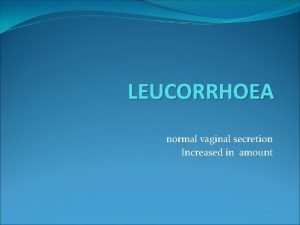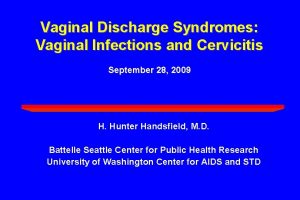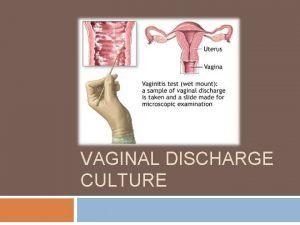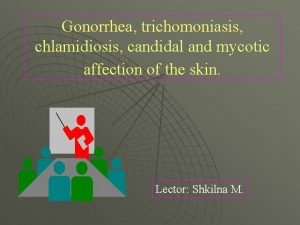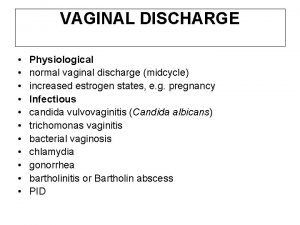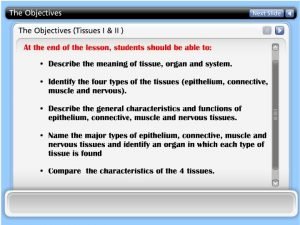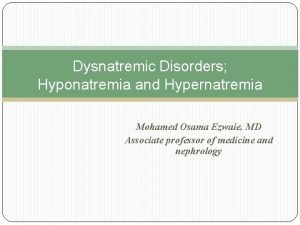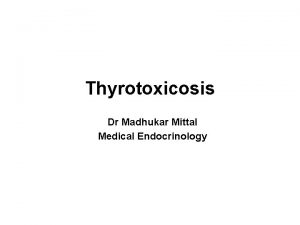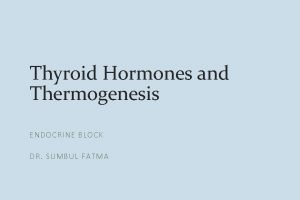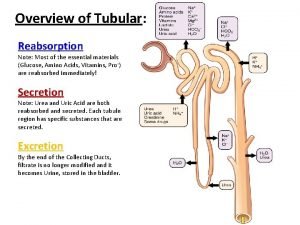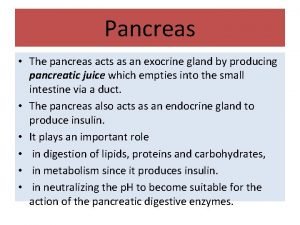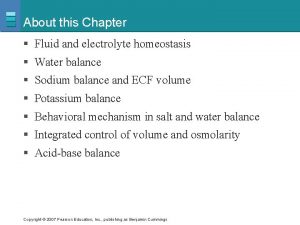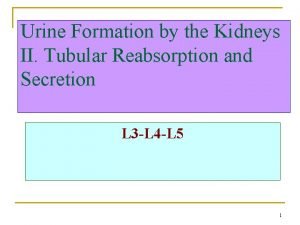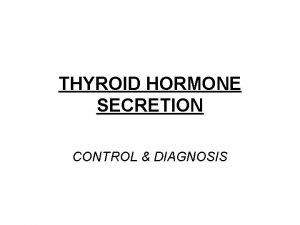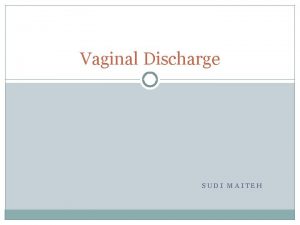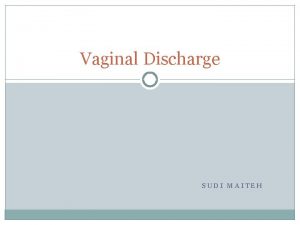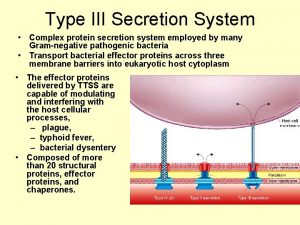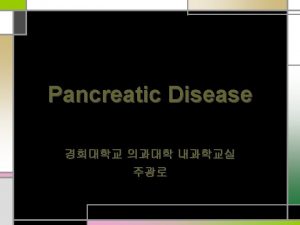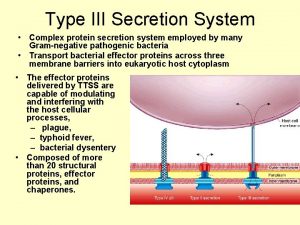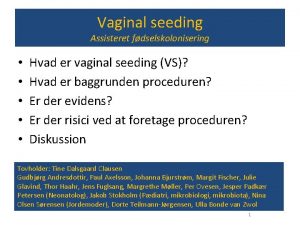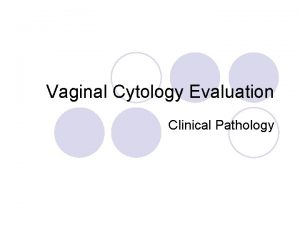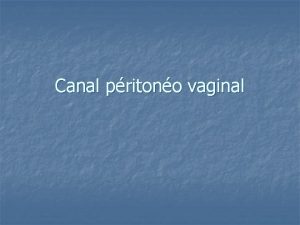LEUCORRHOEA normal vaginal secretion Increased in amount Discharge































- Slides: 31

LEUCORRHOEA normal vaginal secretion Increased in amount

�Discharge is macroscopically and microscopically non-purulent �Permanent vulval moistness �Non irritant �Non offensive �Non pruritic

Physiological Leucorrhoea �At puberty �At ovulation �During premenstrual phase �During pregnancy

Classification of non pathogenic leucorrhoea �Cervical leucorrhoea �And Vaginal leucorrhoea

�Cervical leucorrhoea due to increased mucous secretion from endocervical glands �Chronic cervicitis �Cervical erosion �Mucous polypi �And ectropion.

Vaginal leucorrhoea �Originates in vagina. �Transudation through vaginal wall �Local congestive states like �Pregnancy state �Acquired retroversion �Prolapsed congestd ovaries �Chronic PID. , Chronic Constipation �Sedentary life

differentiated from vaginal infections �By a proper history taking �Complete medical examination A Per Speculum examination of vagina and Cx A Careful bimanual pelvic examination And a bacteriological examination.

Vaginal infections

Trichomoniasis

Etiology �Most common form of vaginitis , seen in 50% women complaining of white discharge. �Can occur at any age but most commonly seen in young adults. �In vagina invariably accompanied by staphylococci , streptococci , enterococci etc.

Trichomonas Vaginalis �Ovoid motile flagellated parasite 18 -20 micron in length and 8 -10 micron in width. �It has 4 anterior flagella and an axostyle which traverses its body to end in a spike.

Mode of infection �Sexual transmission from a infected asymptomatic male partner. �Indirect contact through bed linen , towels , improperly sterilized surgical instruments , contaminated swimming pools etc. �Hospital acquired.

Pathology �Essentially involve vaginal epithelium. � 70 -80 % cases cause acute or chronic urethritis. �Inflammation of Bartholin’s glands. �Involvement of endocervix to cause endocervicitis. �Optimal p. H for activity is 5. 5 -6. 5 which is seen immediately after menstruation.

Clinical picture – symptoms �First symptom is sudden onset purulent vaginal discharge often dating from menstruation. �Cream or greenish colored , frothy discharge. �Severe pruritis in and around introitus. �Dysuria �Dyspareunia.

Clinical picture – signs �Edematous labia minora and introitus. �Diffuse fiery red colored vagina and cervix – “ strawberry appearance “. �Congested and pouting external urinary meatus.

Diagnosis �Wet smear of vaginal discharge when observed under microscope trichomonas can be visualized by their rotatory movements. �Culture on Kupferberg’s or Feinberg – Whittington media.

Treatment �Metronidazole – tab 2 gm single dose for both husband wife / 400 mg twice daily for 1 week. �Secnidazole – 2 gm single dose orally equally effective with less side effects. �Metronidazole / clotrimazole – 100 mg pessary kept intravaginally for 3 -6 days. �Avoid sharing of personal clothing during treatment.

Candida vaginitis

Candida albicans �It is a small Gram positive fungus which develops pseudomycelial threads with septate divisions and blastospores. �It thrives on carbohydrates and likes an acid medium p. H 4. 0 -5. 5.

Etiology �Caused by an organism called Candida albicans. �It usually has a wide distribution in the body. �It is demonstrated in the mouth (25%) , peri anal region (8%) and vagina (2025%) of all women.

Etiology �Active infection occurs in conditions like - Pregnancy - Diabetes mellitus - HIV - Anti cancer drugs - Long term use of OCPS - Prolonged antibiotic use

Mode of infection �Sexual transmission from an infected male partner. �Infection from other parts of the body- alimentary canal , hands , feet and peri anal skin. �From infected mother to the child during vaginal delivery.

Clinical picture �Vaginal discharge which is typically thick, cheesy or curdy, forms plaques which are adherent to vaginal mucosa , they tend to bleed when separated from the vaginal mucosa. �Vaginal and vulvar pruritis. �Dyspaerunia �Multiple hemorrhagic spots seen in the vagina. �Edematous vulva and vagina.

Diagnosis �Direct wet smear observation under microscope after adding normal saline or 10% KOH showing the presence of mycelia or yeast cells. �Culture using Sabouraud’s dextrose media or Nickerson’s media.

Treatment �Topical preparations – 1. Vaginal pessaries – miconazole 100 mg X 6 nights , clotrimazole 500 mg single dose , ticonazole 300 mg single dose. 2. Vaginal creams – 1% clotrimazole , 2 % miconazole , sertoconazole for 1 -5 nights. �Oral – ketoconazole 100 -200 mg BD X 5 days, itraconazole 200 mg BD X 1 day or fluconazole 150 mg single dose.

Bacterial Vaginosis

Gardenella vaginalis �It is the most common organism associated with bacterial vaginosis. �Small pleomorphic coccobacillus which is Gram variable. �It is found attached to epithelial “clue cells”. �Other microorganisms associated with BV is mycoplasma , peptococci, peptostreptococci , bacteroids etc. �It is a sexually transmitted disease.

Etiology �Commonly seen in patients with – - IUCD - Post partum endometritis - Post abortal PID - Post hysterectomy vaginal cuff cellulitis

Clinical picture �Patient characteristically present with a homogenous , white , non viscous , malodorous , uniformly adherent vaginal discharge. �Minimal pruritis seen.

Diagnosis BV is diagnosed when at least 3 of the following are seen – 1. Characteristic white homogenous discharge. 2. Positive whiff test – discharge mixed with 10% KOH gives a fishy odor. 3. Vaginal p. H >4. 5 4. 20% or more Clue cells seen. Vaginal cultures not useful.

Treatment �Metronidazole 400 mg thrice daily for 5 -7 days. �Clindamycin 300 mg twice daily for 7 days.
 Candida albicans blastospores
Candida albicans blastospores Vaginal discharge
Vaginal discharge Vaginal discharge meaning
Vaginal discharge meaning Clue cells
Clue cells Trichomoniasis in women
Trichomoniasis in women Female discharge chart
Female discharge chart Criteria for normal vaginal delivery
Criteria for normal vaginal delivery Holocrine secretion
Holocrine secretion Wiley
Wiley Tubular secretion
Tubular secretion Hyponatremia correction
Hyponatremia correction Gianuzzi demilune
Gianuzzi demilune Where does secretion occur in nephron
Where does secretion occur in nephron Ingestion digestive system
Ingestion digestive system The stomach
The stomach Enteropancreatic reflex
Enteropancreatic reflex Saliva composition
Saliva composition Synthesis and secretion of thyroid hormones
Synthesis and secretion of thyroid hormones Composition gastric juice
Composition gastric juice Thyroid hormone secretion
Thyroid hormone secretion Type 3 secretion system
Type 3 secretion system Tubular reabsorption
Tubular reabsorption Pancreas acts as
Pancreas acts as Difference between duct and gland
Difference between duct and gland H+ secretion in proximal tubule
H+ secretion in proximal tubule Amiloride
Amiloride Secretion of bicarbonate ions
Secretion of bicarbonate ions Gsis
Gsis Erythropin
Erythropin Where does tubular secretion occur
Where does tubular secretion occur Type 3 secretion system
Type 3 secretion system Nephron reabsorption and secretion
Nephron reabsorption and secretion
